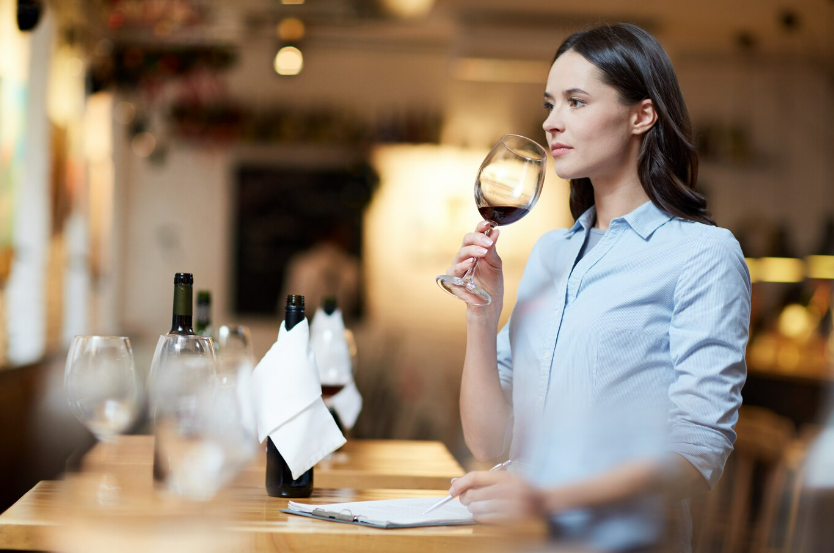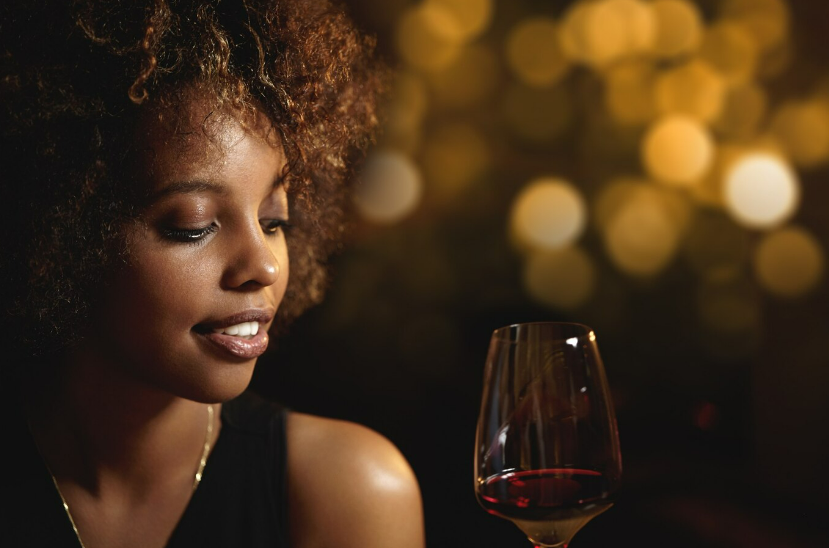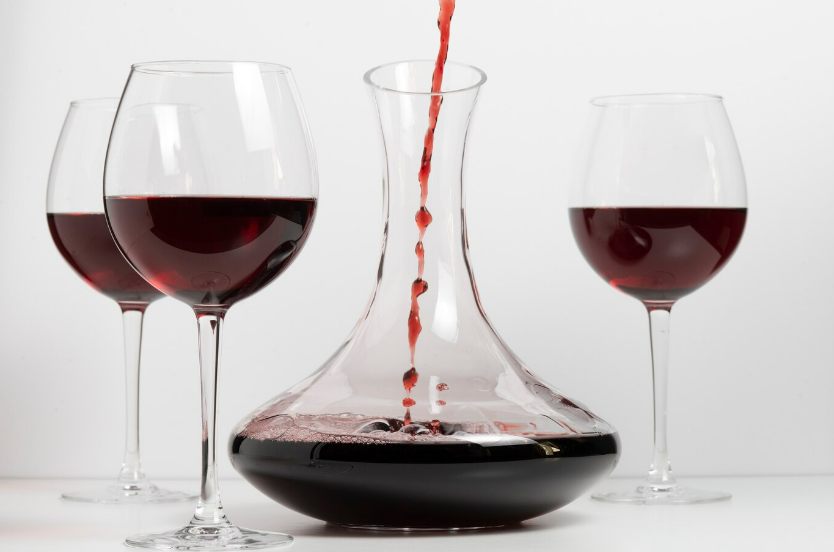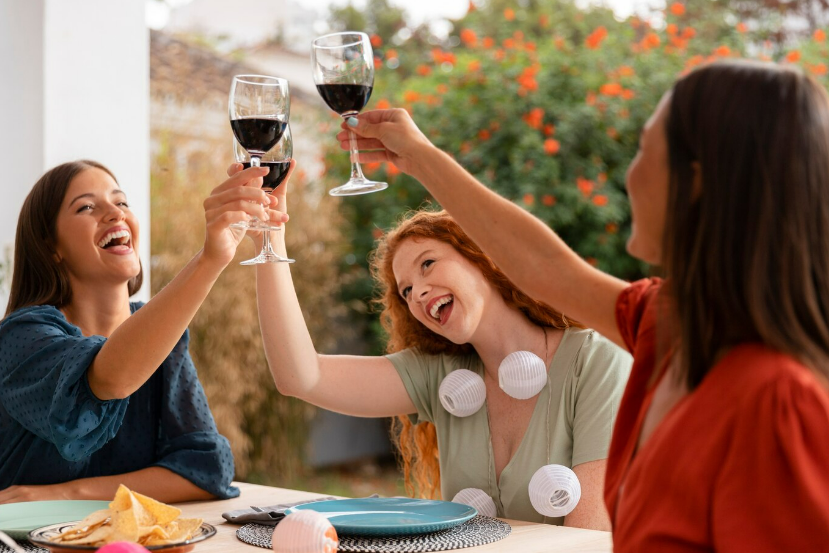
Wine tasting is an exquisite journey through flavor and aroma. To fully appreciate this experience, there’s a recommended order for enjoying different wines. Just like a well-composed symphony, the sequence of wines unfolds, allowing your palate to savor each note to its fullest. We’ll delve into the reasons behind this order, exploring factors like body weight, acidity, tannins, and sweetness. The order in which you drink wine can significantly impact your enjoyment of the experience. Similar to a musical composition, different wines possess unique characteristics that unfold best in a specific sequence. By understanding these principles, you can elevate your wine tasting journey, savoring the full spectrum of flavors and aromas each variety offers.

The Art of the Sip – Unveiling the Symphony of Wine Tasting
Have you ever uncorked a bottle of wine, taken a sip, and felt a tinge of disappointment? Perhaps the flavors seemed muted, or the finish felt harsh. This experience, while common, can be easily remedied by understanding the art of wine tasting, particularly the importance of order. Just like a well-composed symphony, where instruments are introduced in a specific sequence for a harmonious effect, the order in which you taste wines plays a crucial role in maximizing your enjoyment.
The Magic of Wine Tasting
Wine tasting transcends mere drinking. It’s a sensory exploration, a journey that engages your sight, smell, and taste. As you swirl the wine in your glass, the light dances through, revealing its color and clarity. On the nose, a symphony of aromas unfolds, hinting at the grapes used, the winemaking process, and even the terroir (the land where the grapes were grown). Finally, the moment of truth arrives – the sip. The wine washes over your palate, leaving behind a tapestry of flavors and textures that linger long after you swallow.
The Order Unveiled
The sequence in which you taste wines isn’t just about personal preference; it’s a dance with science. Several key factors influence the ideal order:
Body Weight: Wines come in a range of “weights,” from light and delicate to full-bodied and robust. Imagine a feather and a bowling ball. Lighter wines, like Pinot Grigio or Sauvignon Blanc, are like feathers, cleansing your palate and preparing it for the bolder flavors of a full-bodied Cabernet Sauvignon, which would be like the bowling ball. Starting with a heavier wine would overwhelm your palate and mute the subtleties of a lighter one.
Acidity: The acidity level in wine plays a vital role in its perceived freshness and crispness. Think of a refreshing glass of lemonade versus a glass of flat soda. High-acidity wines, like Riesling or Sauvignon Blanc, act as palate cleansers, allowing you to appreciate the nuances of wines with lower acidity, such as Pinot Noir or Merlot.
Tannins: Tannins are naturally occurring compounds found in grape skins and seeds. They contribute to the dryness and astringency of a wine. Imagine the sensation of biting into unripe grapes. High-tannin wines, like Cabernet Sauvignon or Nebbiolo, can overpower the delicate flavors of wines with lower tannins, such as Pinot Noir or Gamay. Therefore, it’s best to save the bolder tannic wines for later in the tasting sequence.
Sweetness: Wines range from dry (little to no sweetness) to sweet (noticeable sweetness). Imagine a glass of unsweetened iced tea versus a glass of fruit punch. Sweeter wines can dull your palate’s ability to perceive the subtle flavors of drier wines. So, the recommended approach is to start with drier wines and progress to sweeter ones.
A Roadmap to Exploration
This section has just opened the door to the captivating world of wine tasting. In the following sections, we’ll delve deeper into each of these key factors, exploring their scientific underpinnings and how they influence the ideal order for enjoying different types of wines. We’ll then embark on a practical guide, outlining the recommended sequence for tasting various styles of wines, from sparkling wines to reds and dessert wines. Finally, we’ll touch upon some additional considerations, such as flexibility based on personal preference and food pairing.

The Science Behind the Sequence: Understanding Key Factors
Body Weight: The Dance of Texture on Your Palate
The body weight of a wine refers to the perception of its viscosity or mouthfeel. It’s not simply about how heavy the bottle feels! Imagine dipping your finger in different liquids – water feels light and thin, while syrup feels heavy and thick. Wines fall somewhere in between this spectrum.
There are three main categories of body weight in wine:
- Light-bodied: These wines feel light and refreshing on the palate. They have a lower alcohol content (typically 12-13.5%) and are less viscous. Think of them like a light summer breeze. Examples include Pinot Grigio, Sauvignon Blanc, and Gamay.
- Medium-bodied: These wines strike a balance between light and full-bodied. They have a moderate alcohol content (typically 13.5-14.5%) and offer a more substantial mouthfeel. Imagine a gentle current in a stream. Examples include Chardonnay (unoaked styles), Merlot, and Pinot Noir.
- Full-bodied: These wines feel weighty and rich on the palate. They have a higher alcohol content (typically 14.5% and above) and are more viscous. Imagine sinking your hand into velvet. Examples include Cabernet Sauvignon, Syrah, and Zinfandel.
How Body Weight Affects Taste Perception
The order of wine tasting is heavily influenced by body weight because it impacts how we perceive other flavors. Lighter-bodied wines act as palate cleansers, preparing your taste buds for bolder experiences. Here’s how it works:
- Starting Light: When you begin with a light-bodied wine, the low viscosity and subtle flavors don’t overwhelm your palate. This allows you to fully appreciate the nuances of the wine, such as its acidity and fruit characteristics.
- Building Up: As you progress to wines with increasing body weight, your palate is gradually prepared for the richer textures and bolder flavors. Imagine brushing your teeth before savoring a complex dessert – your taste buds are reset and ready for the full impact.
- The Downfall of Starting Bold: If you begin with a full-bodied wine, its richness can coat your palate. This can dull your taste perception for the subtler characteristics of lighter-bodied wines you taste later. Imagine trying a delicate white wine after a robust red – the lighter flavors might seem muted.
By following a sequence that starts with lighter-bodied wines and progresses towards full-bodied ones, you ensure your palate is primed to appreciate the full spectrum of flavors in each wine.
Examples and Experimentation:
The following table provides a quick reference for body weight categorization of popular grape varietals:
| Grape Varietal | Body Weight | Examples |
| Pinot Grigio | Light | Pinot grigio delle Venezie |
| Sauvignon Blanc | Light | Sancerre |
| Gamay | Light-bodied to Medium-bodied | Beaujolais Nouveau |
| Chardonnay (unoaked) | Medium-bodied | Chablis |
| Merlot | Medium-bodied | Merlot del Veneto |
| Pinot Noir | Medium-bodied | Oregon Pinot Noir |
| Cabernet Sauvignon | Full-bodied | Napa Valley Cabernet Sauvignon |
| Syrah/Shiraz | Full-bodied | Barossa Valley Shiraz |
| Zinfandel | Full-bodied | California Zinfandel |
Acidity: The Zing on Your Tongue
Acidity is the lifeblood of wine. It’s the component that brings that refreshing zing, brightness, and liveliness that makes your mouth water. It acts like a natural preservative and contributes significantly to a wine’s ageability. But acidity isn’t a one-size-fits-all concept. The level of acidity in a wine can vary greatly, and understanding this variation is key to appreciating the order of wine tasting.
The Science of Sour
Acidity in wine comes primarily from organic acids naturally present in grapes. The two main culprits are:
- Tartaric Acid: This is the dominant acid in grapes, responsible for that sharp, crisp character. It contributes to a wine’s longevity and can be quite noticeable in young wines.
- Malic Acid: This acid gives a greener, more appley or citrusy edge to a wine. Malic acid can undergo a natural process called malolactic fermentation, which converts it to softer lactic acid, creating a rounder mouthfeel.
The Acidity Rollercoaster
High Acidity Wines (Powerhouse Palate Cleansers): These wines, like Riesling or Sauvignon Blanc, boast a noticeable tartness and zip on the tongue. This high acidity acts as a palate cleanser, cutting through richness and preparing your taste buds for wines with lower acidity. Imagine it like a refreshing splash of water before diving into a creamy sauce – it allows you to appreciate the full range of flavors more distinctly.
- Impact on Order: High-acidity wines are typically best enjoyed at the beginning of a tasting. They awaken your palate and set the stage for appreciating the nuances of wines with subtler acidity.
Medium Acidity Wines (The Balancing Act): Many white wines, like Chardonnay or Pinot Grigio, fall into this category. They have a pleasant level of acidity that provides structure and freshness without being overpowering. These wines can be enjoyed throughout a tasting, depending on the specific style and their placement alongside other wines.
- Impact on Order: Medium-acidity wines can be flexible in the tasting order. They can follow high-acidity wines to maintain a sense of balance or precede lower-acidity wines to add some liveliness.
Low Acidity Wines (The Round and Smooth Charmers): These wines, like Pinot Noir or Merlot, have a softer mouthfeel due to lower levels of acidity. They often feel rounder and more opulent on the palate. While they lack the zing of high-acidity wines, they can still be very enjoyable.
- Impact on Order: Low-acidity wines are generally best enjoyed later in a tasting. Their richness and subtle acidity can be easily overwhelmed by wines with higher acidity. Following the high-acidity to low-acidity sequence ensures these smoother wines shine on their own.
Beyond the Basics
Acidity also plays a role in a wine’s ageability. Wines with higher acidity tend to age better, as the acidity acts as a natural preservative. So, the next time you reach for an aged wine, remember, the vibrant acidity you experience might be the reason it’s still going strong!
Tannins: The Astringent Aficionado’s Guide
Tannins are fascinating phenolic compounds found naturally in the skins, seeds, and stems of grapes (and many other plants). They play a crucial role in both the taste and structure of wine, particularly red wine. But what exactly are tannins, and how do they influence the order of wine tasting?
Unveiling the Tannic Grip: Tannins are complex molecules with a puckering, astringent quality that can make your mouth feel dry and slightly rough. Imagine biting into unripe fruit – that drying sensation is a prime example of tannins at work. In wine, tannins contribute a sense of weight and structure, creating a pleasant textural contrast to the fruit flavors.
The Art of Balance: Tannins interact with proteins in your saliva, causing that astringent sensation. This is why high-tannin wines can feel “grippy” or “drying” on the palate. However, tannins also play a vital role in a wine’s ageability. As the wine matures, the tannins soften and integrate with other components, creating a smoother and more complex experience.
The Order of Operations: Now, let’s delve into how tannins impact the sequence of wine tasting. Here’s the key principle: delicate flavors first, bold tannins later.
- Starting Light: Imagine your palate as a canvas. If you start with a wine high in tannins, that astringency can overpower the subtler nuances of lighter-bodied wines you taste later. It’s like painting a bold, dark background before adding delicate details – the finer points get lost.
- Building Up Intensity: Conversely, if you begin with a wine low in tannins, your palate is more receptive to the finer details in subsequent wines. Think of it like laying down a light wash on your canvas first. This allows you to appreciate the subtle complexities of wines with varying tannin levels as the tasting progresses.
The Tannin Trail: Here’s a breakdown of wines based on their tannin content:
High-Tannin Champions: These bold reds pack a powerful punch. Examples include:
- Cabernet Sauvignon: The undisputed king of tannins, known for its intense structure and ageability.
- Nebbiolo: This Italian powerhouse delivers a pronounced grip and complex flavors that unfurl with time.
- Syrah/Shiraz: This versatile grape can produce wines with varying tannin levels, but bold expressions are known for their firm structure.
Mid-Tannin Moderates: These reds offer a balance between structure and fruit. Some examples include:
- Merlot: Often described as softer and rounder than Cabernet Sauvignon, Merlot still possesses some grippy tannins.
- Sangiovese: The backbone of Chianti, Sangiovese provides a firm structure with vibrant acidity, often complemented by subtle tannins.
- Grenache/Garnacha: This grape can produce wines with a range of tannin levels, but some styles offer a pleasant balance with juicy fruit flavors.
Low-Tannin Lightweights: These reds are known for their approachability and focus on fruit flavors. Examples include:
- Pinot Noir: The “red Burgundy” grape is renowned for its elegance and silky texture, with lower levels of tannins.
- Gamay: This grape thrives in Beaujolais, creating wines with bright fruit characters and minimal astringency.
- Dolcetto: This Italian red offers a delightful balance of fresh acidity and gentle tannins, making it highly drinkable.
Sweetness: The Balancing Act on the Palate
Sweetness plays a crucial role in the order of wine tasting as it significantly impacts taste perception. Understanding the spectrum of sweetness in wines equips you to navigate your tasting journey and appreciate the subtle nuances of each sip.
The Sweetness Spectrum
Wines can be classified into three main categories based on their residual sugar content, the amount of sugar remaining after fermentation:
- Dry Wines (0-3 g/L residual sugar): These wines have minimal sweetness and often present a crisp, refreshing taste. Examples include Pinot Noir (red), Chardonnay (white), and Sauvignon Blanc (white). Their dryness allows them to cleanse the palate and prepare it for wines with more subtle flavors.
- Off-Dry Wines (4-12 g/L residual sugar): These wines exhibit a hint of sweetness that balances the acidity, creating a well-rounded mouthfeel. Examples include Riesling (white), Gewürztraminer (white), and Zinfandel (red, can range from dry to off-dry). They can be enjoyed on their own or paired with spicy or salty foods.
- Sweet Wines (over 12 g/L residual sugar): These wines are noticeably sweet and can range from slightly sweet to intensely sugary. Examples include Sauternes (white), Ice Wine (white), and Port (fortified red). They are typically enjoyed as dessert wines or paired with strong cheeses and rich desserts.
The Sweetness Perception Dance
The human tongue has specific taste receptors for sweetness. When you consume a sweet wine first, these receptors become saturated, making it difficult to appreciate the subtle flavors and nuances of drier wines that follow. Imagine tasting a delicate Pinot Noir after a glass of Sauternes – the Pinot Noir’s complexities would likely be muted due to the lingering sweetness on your palate.
Planning Your Sweet Journey: By following a progression of sweetness levels, you can maximize your enjoyment of each wine. Here’s the recommended order:
- Start with Dry Wines: Begin your tasting with dry wines. Their lack of sweetness allows your palate to be fully reset, priming it to detect the intricate flavors of subsequent wines.
- Move to Off-Dry Wines: After experiencing dry wines, explore off-dry options. The subtle sweetness complements the acidity, creating a harmonious taste experience.
- End with Sweet Wines: Conclude your exploration with sweet wines. Enjoying them last ensures their sweetness doesn’t overwhelm the more delicate flavors you’ve previously experienced.

The Order of Wines: A Practical Guide
Sparkling Wines (if included)
Sparkling wines can play a delightful role in a wine tasting depending on the occasion and the purpose. Here’s how they fit in:
- Palate Cleanser: Sparkling wines, particularly those with high acidity like Brut Champagne or dry Prosecco, can act as a refreshing palate cleanser between heavier wines. The effervescence helps clear the taste buds and prepares them for the next sip. This is particularly useful when transitioning from richer white wines to lighter reds or vice versa.
- Celebratory Drink: Sparkling wines are often associated with celebrations and special occasions. Starting a tasting with a celebratory toast of Champagne or Prosecco can set a festive mood and add a touch of excitement to the experience.
White Wines
The journey through white wines typically starts with lighter-bodied styles and progresses towards richer and fuller-bodied options. Here’s a breakdown:
- Light-bodied Whites with High Acidity: These wines, like Sauvignon Blanc, Pinot Grigio, or Unoaked Chardonnay, are excellent choices to begin. Their crisp acidity awakens the palate and prepares it for the tasting experience. Lighter body ensures they won’t overpower your taste buds for the more nuanced wines to come.
- Medium-bodied Whites with Lower Acidity: As your palate adjusts, move on to wines with a bit more weight and texture. Unoaked or lightly oaked Chardonnays, Viognier, or some richer styles of Pinot Grigio fall into this category. These wines offer a fuller mouthfeel while still maintaining some acidity to keep the taste buds engaged.
- Aromatic White Wines: Wines like Gewürztraminer, Riesling (depending on sweetness level), or some Moscatos have pronounced floral or fruity aromas. Their placement can be flexible. Some enjoy them early on for their refreshing qualities, while others prefer them later to fully appreciate their unique aromatic profile. Experiment and see what works best for you.
Rosé Wines
Rosé wines can be a delightful bridge between whites and reds. Their placement depends on the specific style:
- Light-bodied Rosé: Rosé wines made from Pinot Noir or Grenache grapes tend to be lighter-bodied with high acidity. These can be enjoyed alongside lighter-bodied white wines or even as a refreshing palate cleanser between whites and reds.
- Full-bodied Rosé: Rosés made from Syrah or Zinfandel grapes have a bolder presence. They can be enjoyed after lighter-bodied reds or even alongside lighter-bodied grilled meats.
Red Wines
The exploration of red wines starts with lighter styles and progresses towards bolder and more tannic ones:
- Light-bodied Reds with Lower Tannins: Pinot Noir, Gamay, or Barbera are excellent starting points. These wines have a lighter body and lower tannins, making them easier on the palate and allowing you to appreciate their delicate fruit flavors.
- Medium-bodied Reds with Moderate Tannins: As your palate adjusts to red wines, explore wines like Merlot, Grenache, or Schiava. These offer a bit more weight and structure with moderate tannins.
- Full-bodied Reds with High Tannins: Cabernet Sauvignon, Syrah, or Nebbiolo are known for their full body and robust tannins. These wines have a powerful presence and should be enjoyed towards the end of the tasting when your palate is accustomed to bolder flavors. The high tannins can overpower the delicate flavors of lighter wines if consumed earlier.
Dessert Wines
Dessert wines are the perfect way to conclude a tasting on a sweet note. These wines have a higher residual sugar content, making them taste sweeter than dry table wines. Popular choices include:
- Fortified Wines: Port, Sherry, and Madeira are fortified wines with added brandy, resulting in higher alcohol content and sweetness levels. They come in various styles, from dry to very sweet.
- Late Harvest Wines: These wines are made from grapes that have been left on the vine longer to concentrate their sugars. Sauternes, Ice Wine, and some late-harvest Rieslings are examples. Their sweetness complements desserts beautifully.

Beyond the Basics: Additional Considerations
Flexibility and Personal Preference
The suggested order of wine tasting serves as a compass, not a rigid rule. Ultimately, the goal is to enjoy your experience! Here’s how to personalize it:
- Start with what you know and love: If you’re a die-hard red wine enthusiast, feel free to begin there. However, keep in mind the body weight and tannin content to ensure a smooth progression.
- Consider the occasion: Planning a casual get-together? Sparkling wines or lighter whites might be a fun kickoff. Hosting a fancy birthday party? A structured tasting following the order can elevate the experience.
- Experiment with blind tasting: This removes preconceived notions based on color or label, allowing you to focus purely on the sensory experience. Have a friend pour you unidentified samples and see if you can guess the varietal or style!
- Account for food pairings: When wine is paired with food, the order might need adjustments. For example, a lighter-bodied red like Pinot Noir might precede a richer dish that typically calls for a full-bodied Cabernet Sauvignon.
The Magic of Glassware
The right glass can significantly enhance your wine tasting experience. Here’s why:
Shape: Different glass shapes direct the flow of wine to specific areas of your tongue, highlighting certain flavors and aromas.
- Fluted glasses for sparkling wines: The narrow flute helps retain the bubbles, keeping the wine refreshing and lively.
- Universal white wine glasses: These have a wider bowl compared to flutes, allowing for better appreciation of the delicate aromas of white wines.
- Red wine glasses: These have a larger bowl that allows the wine to breathe and release its bolder aromas. The wider opening also helps disperse the tannins, creating a smoother taste.
- Specialty glasses: For specific wine styles like Burgundy or Bordeaux, there are specialized glasses designed to optimize the tasting experience.
The Art of Blind Tasting
Blind tasting is a fun and educational way to challenge your palate and sharpen your sensory skills. Here are some benefits:
- Focuses on sensory perception: Without the influence of color or label, you rely solely on your sense of smell and taste to identify the wine. This hones your ability to detect subtle aromas and flavors.
- Levels the playing field: Expensive labels don’t influence perception. You’re judging the wine purely on its own merits.
- Encourages exploration: Blind tasting introduces you to new varietals or regions you might not have tried otherwise. It can open your mind to a wider world of wines you might enjoy.
Conclusion
The order of wine tasting, while not a strict rule, acts like a guide to maximize your palate’s enjoyment. We learned how body weight, acidity, tannins, and sweetness influence the sequence, allowing you to fully appreciate each wine’s unique character. Feel free to experiment and personalize your tasting journey, discovering hidden gems and developing your preferences. Embrace the exploration, raise a glass, and let the world of wine serenade your senses!













